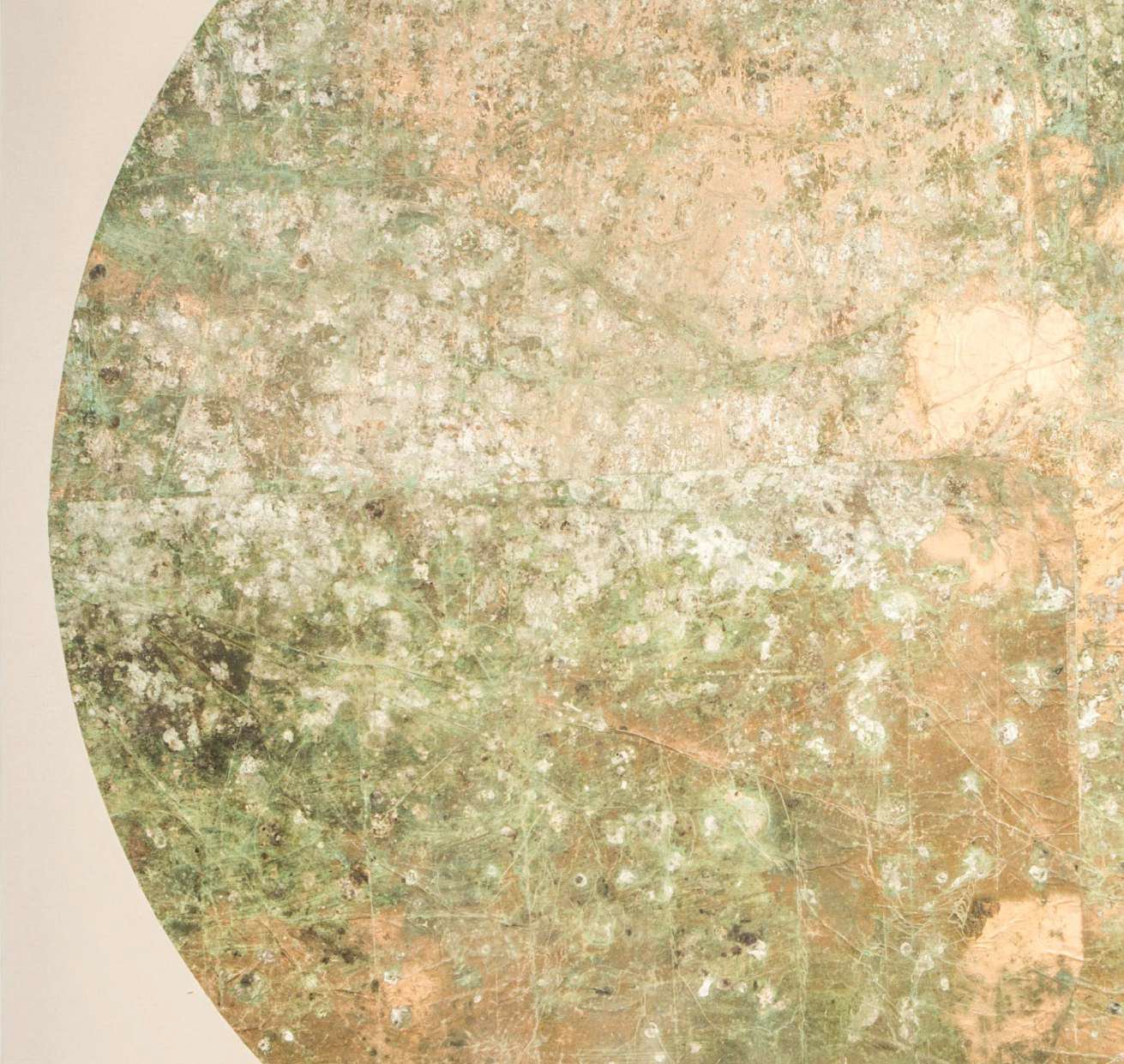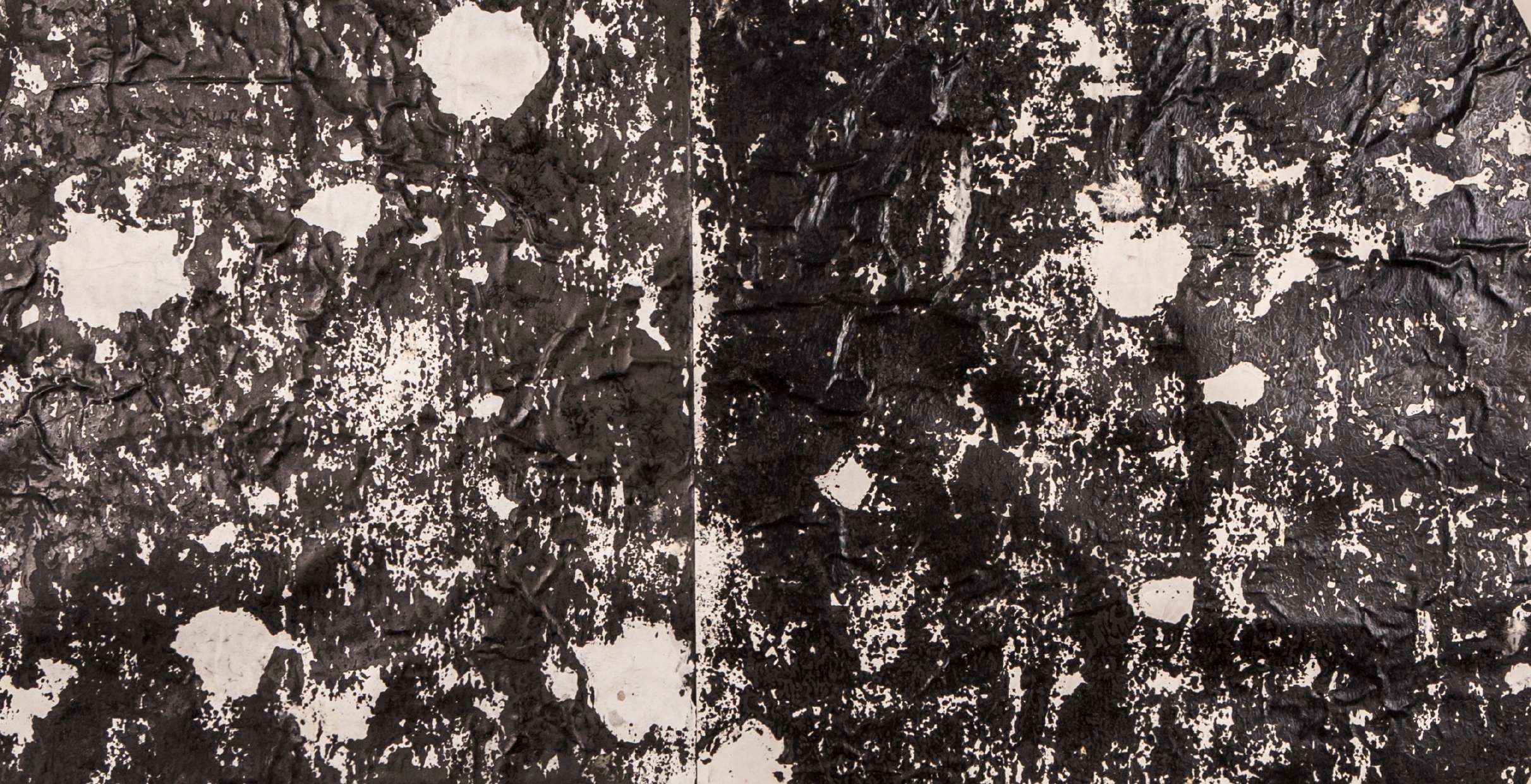“Thinking takes place in the relationship of territory and the earth,” wrote Gilles Deleuze and Félix Guattari in Geophilosophy, an essay published in their 1991 collection, What is Philosophy? Standing right up close to the works of Giancarlo Scaglia, I wonder if that same strange place – somewhere between territory and earth – is where art starts too.
In particular, I’m looking at two pieces from Giancarlo Scaglia’s 2019 series Golden Aerea. At nearly two metres in diameter, each work has an undoubted presence: tinged green-blue and circular, there is a map-like quality to each work, or something like the earth viewed from space. But unlike the two-dimensions of the traditional atlas, Scaglia’s works reveal far more the closer you get: like a crumpled papery landscape of little mountains and rivulets, tinted all copper verdigris blue and jade green, cracked expanses of shimmering gold, smears and splatters of powdery whiteness.
This golden paper is left to be crumpled by birds and the wind, to be washed by the rain and the salt air.
But how are they made? As so often, the list of materials provides a clue: “gold pigment and guano on Kozo paper applied on tocuyo fabric”. Gold and guano? Yes, for Scaglia makes these beautiful works not in the confines of the studio but outside in the landscapes of El Frontón, an island off the coast of Peru. The island has a vexed history: used as a penal colony in the colonial era, it served as a prison until 1986 when a series of riots at El Frontón and other prisons was ruthlessly crushed by the Peruvian military. At least 224 people were killed, many simply executed without trial.
El Frontón is not far up the coast from the Chincha Islands, which were long valued for their extensive deposits of guano. In the nineteenth century, this guano was highly prized and in 1864 the Chincha Islands were at the centre of a naval war between Spain and its former colonies, Chile and Peru. The war ended in 1866 and trade resumed. The guano supplies were all but exhausted by 1874.
This history of blood and gold and guano is written into the tones and textures of Scaglia’s work. He takes sheets of Kozo paper, a delicate-looking but strong Japanese paper made from vegetable fibres, coats them in gold and just leaves them outside on the island. The paper is subject to chance and the weather, the earth and the birds. Gold becomes a substrate for the once-prized guano of pelicans and cormorants and Peruvian boobies. It is left to be crumpled by birds and the wind, to be washed by the rain and the salt air. And then it is all brought home to be assembled in collaged layers together, mounted and hung and sold. Somewhere there is the territory and somewhere there is the earth. And everywhere there is shit and money.
Image credits:
Giancarlo Scaglia, Golden Aerea #13 [detail], gold pigment and guano on Kozo paper applied on tocuyo fabric, 183 x 183cm (2019)
Giancarlo Scaglia, Golden Aerea #12, gold pigment and guano on Kozo paper applied on tocuyo fabric, 183 x 183cm (2019)
Giancarlo Scaglia, Golden Aerea #12 [detail], gold pigment and guano on Kozo paper applied on tocuyo fabric, 183 x 183cm (2019)
Giancarlo Scaglia, Golden Aerea #13, gold pigment and guano on Kozo paper applied on tocuyo fabric, 183 x 183cm (2019)
Giancarlo Scaglia, Golden Aerea #13 [detail], gold pigment and guano on Kozo paper applied on tocuyo fabric, 183 x 183cm (2019)
Giancarlo Scaglia, Stellar map, frottage, etching ink on Japanese paper, 74 x 97cm each (2019)
Giancarlo Scaglia, Sol negro #1, frottage, etching ink on Japanese paper, 183 x 183cm (2019)
Giancarlo Scaglia, Sol negro #1 [detail], frottage, etching ink on Japanese paper, 183 x 183cm (2019)
Giancarlo Scaglia, Untitled, frottage, etching ink on Japanese paper, 230 x 230cm (2019)
For more information on Giancarlo Scaglia, visit Revolver Galeria, Lima and Buenos Aires.
This is part of ROOT MAPPING, a section of The Learned Pig devoted to exploring which maps might help us live with a clear sense of where we are. ROOT MAPPING is conceived and edited by Melanie Viets.








